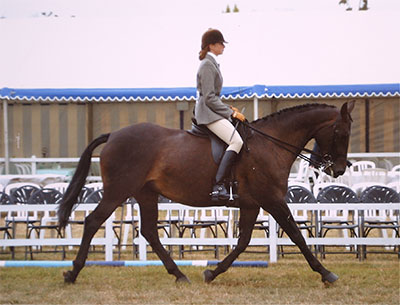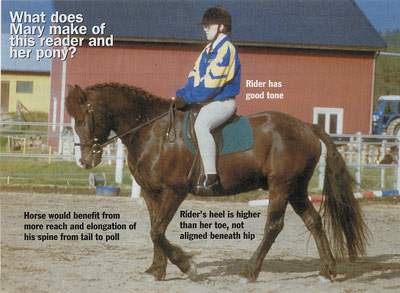RWYM
ARTICLE 41
 This little horse looks like he is having a great time jumping, although I suspect that his rider is less enthusiastic than he is! She has a rather fragile precarious look, and I imagine that she may be one of those riders who has to steel herself to go across country (or perhaps even to jump!). Her whole body is much too far forward, and too far up above the horse – for as he leapt forward and up into the air, so did she. There is a compelling instinctive logic to this, and novice riders have a hard time believing that the correct response to the explosive power of take off is to move your backside backwards rather than forwards – to fold down rather than to stand up. But more of that later.
This little horse looks like he is having a great time jumping, although I suspect that his rider is less enthusiastic than he is! She has a rather fragile precarious look, and I imagine that she may be one of those riders who has to steel herself to go across country (or perhaps even to jump!). Her whole body is much too far forward, and too far up above the horse – for as he leapt forward and up into the air, so did she. There is a compelling instinctive logic to this, and novice riders have a hard time believing that the correct response to the explosive power of take off is to move your backside backwards rather than forwards – to fold down rather than to stand up. But more of that later.
Whilst one could look at this rider’s position and pick it apart piece by piece, I suspect that the underlying problem lies in her breathing. I would lay a bet that she breathed in quite a few strides ago (one of those sudden, sharp inbreaths that pulls your rib cage up and leaves your shoulders up around your ears), and has yet to breathe out! It is as if she went “Eek!” at the sight of the jump, and to me at least, the trauma of jumping is writ large in her body. It is however possible that she considers herself “gung ho” about jumping, in which case I would venture to suggest that she is “unconscious of her incompetence”. (This is the state in which ignorance is bliss.) But it is far more likely that she is not as happy and confident as she would like to be – and if I were flying up above my horse like this, I’m sure that I would not feel happy or confident either!
Her “Eek!” has almost certainly affected her horse’s jump. Notice that he has not taken off with both hind legs together, and neither are his forelegs together. He has scrabbled over the fence – but has given it lots of room, and is probably a scopey jumper. I think he would make a lovely bascule in the right circumstances – but he needs a little help from his rider. His natural enthusiasm is carrying him through, and I am sorry to say that he is doing as well as he is more despite his rider than because of her. (His type, size and colouring make me wondour if he is a Conemara/thoroughbred cross. These little horses make terrific eventers, and are one of my favourite types.) Our rider deserves mammoth congratulations for at least one aspect of her performance, however. For precarious though she is, she has not pulled her horse in the mouth. If more rein were given he might use it by lengthening his neck; but his rider is not restricting him badly.
One of my favourite exercises in gridwork lessons is designed specifically for riders who have an “Eek!” about jumping. I can almost always reduce this by setting up a numbering scale for the quality I call “brain space”. This predominantly concerns the sense of how much time you feel you have, into, over, and after the fence. Perceiving every footfall would count as a 10, whilst actually “blanking out” over the fence would count as a 0. (This may sound strange to you, but believe me, many riders do it. They all but go unconscious!)
A larger percentage of riders find that the jump whizzes past them so fast that they barely know what hit them. They then “come to” several strides after it, and may even find themselves wondering, “Am I still alive?”. Meanwhile, they are rapidly approaching the next fence, and are feeling more and more “out of it” as their jumping round progresses. They would do much better if they had their brain in the here-and-now after the fence, so that they could set the horse up for the next jump, rather than still feeling victimised by the last one!
Each time a rider has been through the grid, I ask her to tell me the number which corresponds to her brain space during that ride. Very soon, her brain space starts moving up the scale, whilst her anxiety starts moving down. She begins to feel more comfortable with jumping. But the greater benefit is that she can now begin to take in what I am saying to her, for when her brain space is low, my suggestions come to nothing. The rider may not even hear them – but even if she does, she is certainly in no position to implement them!
Note that having your brain space high does not necessarily mean that everything will go perfectly. One of my colleagues tells the story of how her horse pecked on landing after a large fence at the end of a grid. As he landed on his nose and his knees, no one could believe that she stayed in the saddle. Her answer was that her brain space was so high that she felt everything happen in glorious slow motion, and had plenty of time to be sure that she made the necessary adjustments!
So, I now offer my suggestions in the hope that both our rider in the photograph, -and you my reader – will have enough brain space to implement them. When you fold down over a fence think of folding down like an ironing board. (This image is not a Mary Wanless original. It comes from jumping trainer Pat Burgess.) This means that the angle behind your knee closes, and does not open as one sees in this picture. This is the crucial difference between standing up and folding down. Our rider may struggle somewhat to change this, even if she understands intellectually that leaping into the air like your horse does not keep you in balance with him! For her joints must give, and not lock, as I believe they have done in this picture. Her general anxiety is probably the source of this tension, and breathing deeply whilst focussing on brain space will help her to eradicate it.
Folding down like this moves your backside towards the back of the saddle, and not up the horse’s neck. Think of bringing your belly button onto the pommel, and practice doing this in halt. As you fold down, also think of pushing your heel down and forward, for this keeps you in balance over your feet.
To give you a more immediate understanding of this dynamic, stand in an “on horse” position on the ground, and notice whereabouts on your feet your weight is taken. Is it more on your heels, or more on the ball of your foot? Now fold down like an ironing board. Realise how this exercise shows the folly of throwing yourself up and forward – for if you attempted to do so now you would land in a heap on the floor!
As you fold down, give your hand forward, as if passing it up the horse’s crest. (There is rarely any harm done by giving too much over a fence, but much harm is done by giving too little.) As you balance in this position, notice whereabouts on your foot your weight is taken. You will almost certainly find that it is more on your heel than before, and you can probably balance like this with only the heels of your shoes resting on the floor. Then come back up to your starting position, noting how the weight moves more onto the balls of your feet. This difference explains why you must push your heel down and forward when jumping (but not in your flatwork).
Come back now to the photograph, and realise that if you were flying up in the air above your horse like this rider, it would be totally appropriate to feel anxious. The way to feel safe is to take on the position (and the breathing pattern) of safety. This is what skilled, confident riders do. The pay-offs are huge – especially given that your anxious posture can so easily become a self-fulfilling prophecy. It then provides you with the type of experience which tends to result in more anxiety!
For instance, the rider in this picture was almost certainly in front of her horse in the few strides before take off, and was therefore in a very vulnerable position should he have thought about stopping. (He does look, however, as if nothing was further from his mind.) If all the rider’s weight is positioned over the horse’s forehand just as he as attempting to lift it off the ground, he may well decide that the effort is just too much. This rider position makes it mechanically very hard for him to jump, and it saps his confidence more than any other. So if your anxiety causes you to tip forward on or before take off, your horse has probably stopped with you already… and as a result you probably feel as if you really do have something to be anxious about!
. But even if you survive take off in this position, your imbalance will cause you to land in a heap on his neck on landing, and neither of you will find this an edifying experience. So it is perfectly reasonable for someone who is “in front of the horse” to feel nervous about jumping. Confidence is a body posture and a breathing pattern as well as a state of mind. When your body is secure over fences, you will begin to feel confident.
In my days as a young trainee, I got the distinct impression that my instructors considered that anyone who was nervous of jumping was daft. I take a different view. Anyone who is insecure over fences, and who is nervous of jumping is very sane. Personally, I think that the daft ones are the people who are insecure in their jumping position, but very “gung-ho” in their attitude. They are the ones who are “unconscious of their incompetence”, and they are a danger to themselves and their horses.
I wish that a smaller proportion of the event riders at the lower levels came into this category. Those at the top usually have fantastic style, and loads of brain space – and they rely on these when things go wrong. These are the qualities which make them stand out from the crowd.
I hope that the rider in our photo will work over grids with an instructor who is astute enough and sympathetic enough to help her make the changes she needs. This, I hope, will enable her to be more of a help her fabulous little horse. I then hope that she begins to feel more confident in her jumping, and that they have a fabulous time together!












